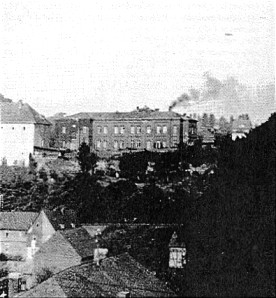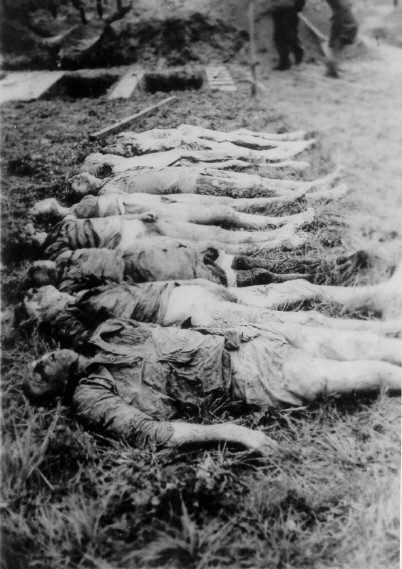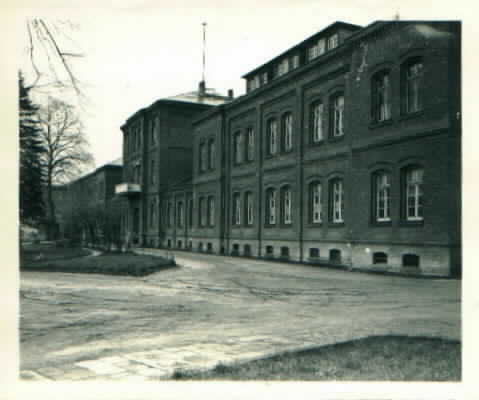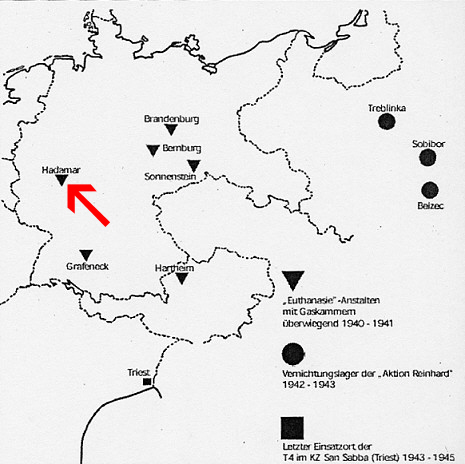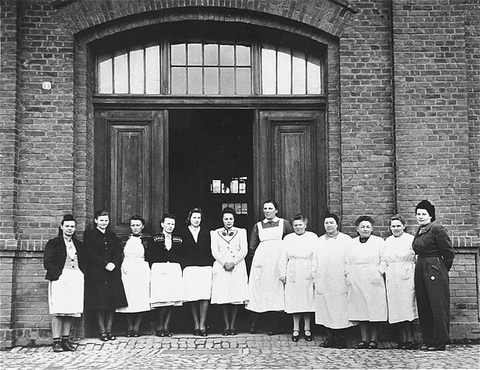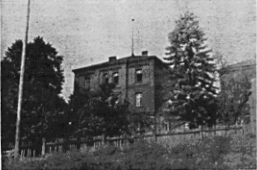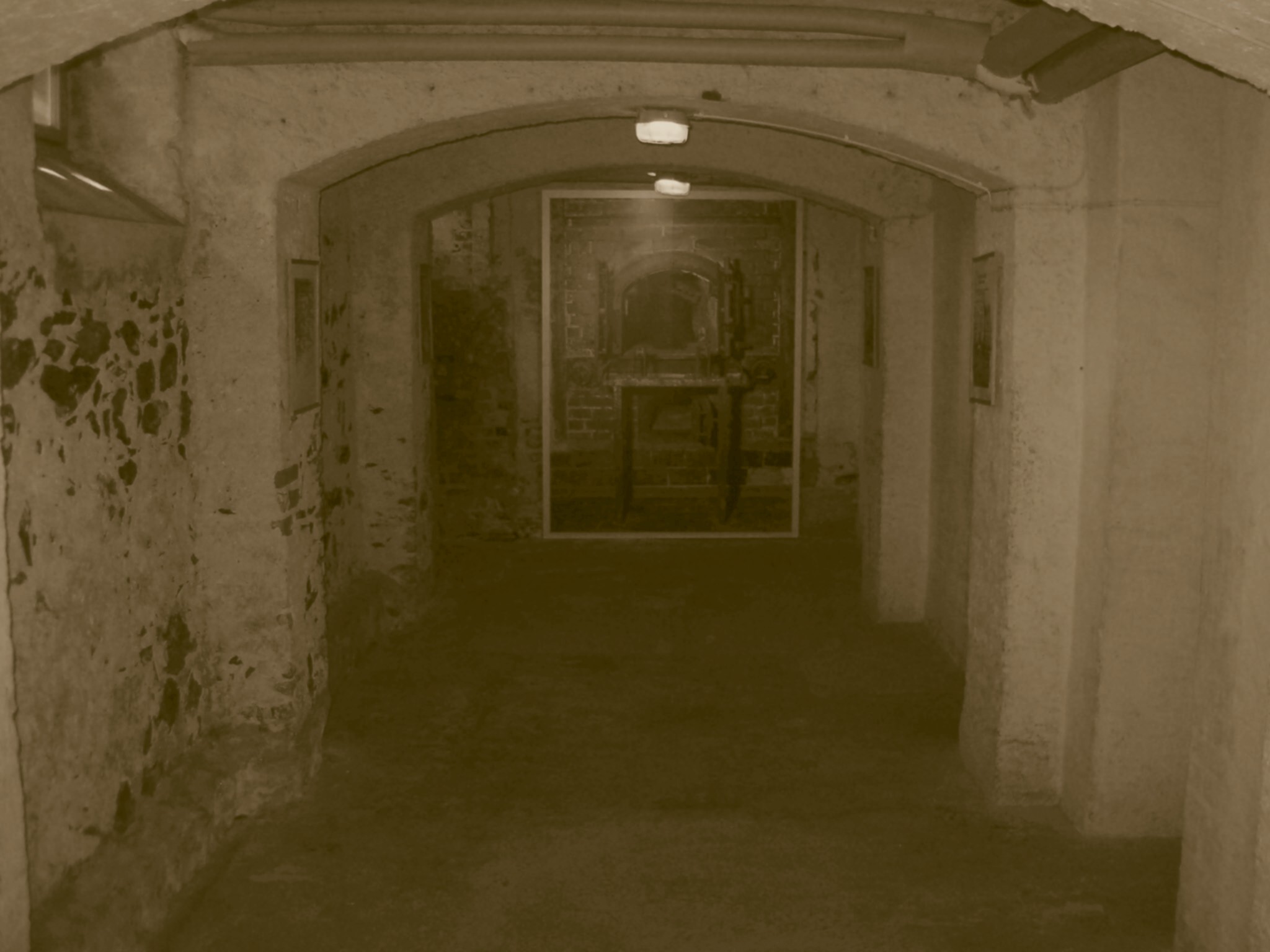Holocaust Education & Archive Research Team |
Euthanasia
Nazi Eugenics & Euthanasia T- 4 Staff T- 4 in Poland T - 4 in Germany & Austria | |||||||
Hadamar Euthanasia Center
Located on a hill, the Möchsberg, overlooking the town of Hadamar, near Limburg-an-der-Lahn in Hesse, a Korrigenden-Anstalt (Correctional Institution for Released Prisoners) was founded in 1883. As the number of mentally disturbed persons in Germany increased in the early years of the 20th century, additional medical facilities were considered necessary.Thus in 1906 the Korrigenden-Anstalt in Hadamar was converted to a mental institution. By 1930 the home contained 320 patients. As decreed by Nazi law, from 1934 nursing costs for mental patients were reduced. By 1936 the mental homes had become overcrowded, and conditions worsened as a result of the reduced quantity and quality of food supplies. The building had been designed to accommodate 250 patients, but by 1939 about 600 inmates were crowded into cramped quarters.During late August 1939, following Hadamar’s designation as a military hospital, patients were distributed to surrounding mental homes. However, between November 1940 and January 1941 the sickrooms were converted into quarters for the medical and administrative staff of the new T4 Hadamar euthanasia killing centre. The staff had been transferred from Grafeneck following the closure of that facility.Rooms to receive arriving patients were located on the first floor. A gas chamber disguised as a shower room was installed in the basement of the building, together with a crematorium with two ovens which were attached to a chimney. Gas entered the chamber from an adjacent room through pipes with holes punched in them.Large grey buses arrived daily carrying victims from nearby mental homes at Herborn, Weilmünster, Kiedrich, Idstein, Nassau, Langenfeld, Andernach, Wiesloch, and Weinsberg (the Zwischenanstalten / intermediate mental homes). From the garage the victims were conducted through the so called "sluice" (a narrow fenced-in path) to the extermination building. The Hadamar "sluice" became the model for the "sluices" or "tubes", later used in the extermination camps of Aktion Reinhard.Signs on the road leading to Hadamar warned that the danger of epidemics prohibited entry, but the chimney's smoke and the smell could not disguise the nature of the operation from local inhabitants. From the commencement of gassing operations on 13 January 1941 until August of that year, approximately 100 victims were killed every day. A witness testified about the killing sequence at Hadamar:
A further witness described observing the victims through the peephole during a gassing:
A third witness stated:
Some time in August 1941, a bizarre party was held in Hadamar to celebrate the gassing and cremation of the ten thousandth patient:
Another witness reported that the celebration, which included music, continued with a drunken procession through the grounds of the institution.On 24 August 1941, the killing at Hadamar was suspended on Hitler's orders. The bishop of Limburg had protested that pupils of schools in Hadamar called the Gekrat buses “killing crates” and threatened each other with the words: “You’ll end up in the Hadamar ovens!” People were saying: "Germany cannot win the war if there is still a just God." The installations in the cellar were dismantled and other rooms converted back to sickrooms. Many of the staff were ordered to the east to eventually use the murderous knowledge they had acquired at the soon-to-be established extermination camps. It is suspected, although never proven, that a group of 20-30 doctors, nurses, and other personnel, drawn mainly from Hadamar and Sonnenstein, conducted “euthanasia” on severely wounded German soldiers on the Russian front before proceeding to kill on a much greater scale as part of Aktion Reinhard.
Killing at Hadamar recommenced in 1942 as part of the second phase of the euthanasia program, the so-called “wild euthanasia.” Now the victims were murdered by administering lethal doses of barbiturates or morphine-scopolamine injections. While initially there had been some pretence of medical deliberation before deciding on a patient’s fate, with the arrival of Polish and Russian workers in 1944, mostly diagnosed as “tubercular” despite a complete lack of medical examination until after their death, the killing became automatic. When pressed at a post-war trial, the chief female nurse finally admitted that what had occurred could only be described as murder.On 15 April 1943, a ward for Jewish children of mixed marriages was created, camouflaged as an "educational home." This ward would eventually receive children from all parts of the Reich. The exact number of Jewish children transferred to Hadamar during 1943 and 1944 is not known, but it is certain that most were healthy and that they were sent to Hadamar because they were partly Jewish. As the deportation guidelines exempted these children, the bureaucracy of the Ministry of the Interior, not the SS or police agencies, decided to destroy at least those children within its control that the regime defined as Jewish. At Hadamar these healthy children were killed with injections.Until late August 1942, bodies had been buried at the town's cemetery, but from September of that year mass graves located behind the building were used. During October 1944, more than 700 inmates were crowded together at the home. On 26 March 1945, US Forces captured the town of Hadamar. In the institute's pharmacy 10 kilograms of the barbiturates "Veronal" and "Luminal", used to sedate or kill the victims, were found.Members of Hadamar's personnel were put on trial in 1945 in Wiesbaden, and in 1947 in Frankfurt/Main. They were found to be responsible for killing approximately 10,000 persons. At the Hadamar trial of October 1945, one of the first American war crimes trials, Colonel Leon Jaworski described the murder of patients by their physicians in the following terms:"Oh, what a vicious falsehood, what a terrible thing, what an evil and wicked thing to do to a person who is already suffering and already carrying burdens, to build up the false hope that sunshine was to enter their hearts. They told them they would be given medication that would help them. Oh, yes, they were given medications, medications of poison that gripped their heart and closed their eyelids still; that is the sort of medication they were given."
During the 1950s all prisoners were pardoned. Later investigations established a figure of at least 10,072 victims gassed at Hadamar. To this must be added a minimum of 4,000 further individuals killed as a result of “wild euthanasia.”A number of Aktion Reinhard personnel served at Hadamar, including Kurt Arndt, Kurt Bolender, Max Bree, Kurt D., Werner Dubois, Karl Frenzel, Hubert Gomerski, Karl Gringers, Willy Grossmann, Gottlieb Hering, Josef Hirtreiter, Robert Jührs, Erwin Kainer, Johann Klier, Fritz Kraschewski (probably), Erwin Lambert, Werner Mauersberger, Willi Mentz , August Miete, Philipp Post, Wenzel Rehwald, Karl Schluch, Erich Schulz, Hans-Heinz Schütt, Erwin Stengelin, Franz Suchomel, Heinrich Unverhau, Christian Wirth, Franz Wolf and Ernst Zierke.
Sources: Bergen, Doris L. War and Genocide: A Concise History of the Holocaust, Rowman & Littlefield Publishers, Inc., Lanham, Maryland, 2003. Friedlander, Henry. The Origins of Nazi Genocide: From Euthanasia to the Final Solution, University of North Carolina Press, Chapel Hill, 1995. Kogon, Eugen; Langbein, Hermann; Rückerl, Adalbert; eds. Nazi Mass Murder, Yale University Press, New Haven and London, 1993 Lifton, Robert Jay. The Nazi Doctors – Medical Killing and the Psychology of Genocide, Papermac, London, 1990. http://www.chgs.umn.edu/Histories__Narratives__Documen/Hadamar/hadamar.html
Copyright NJL 2007 H.E.A.R.T |
